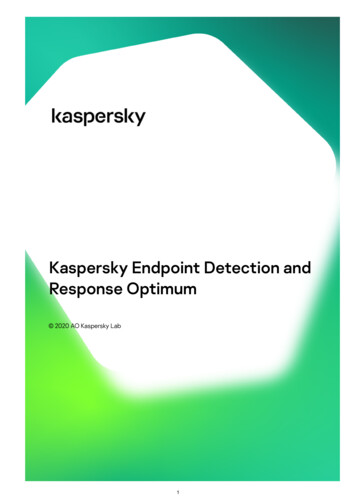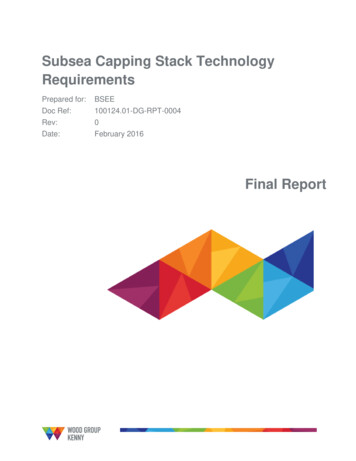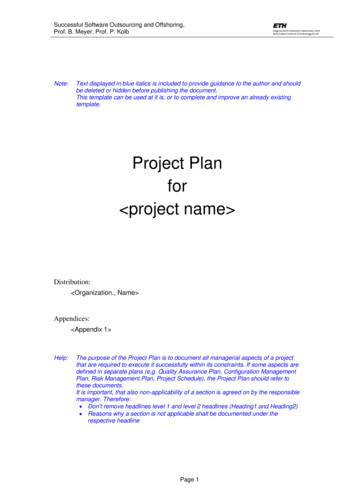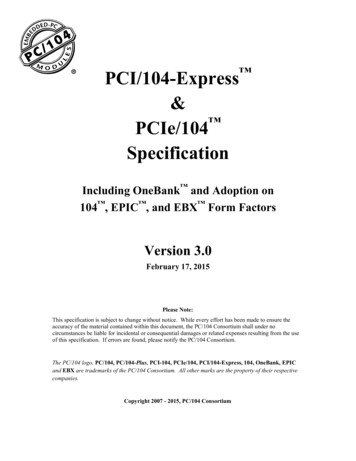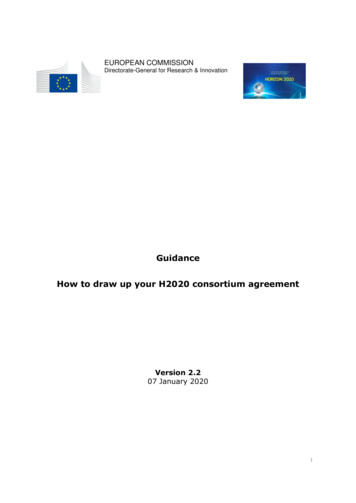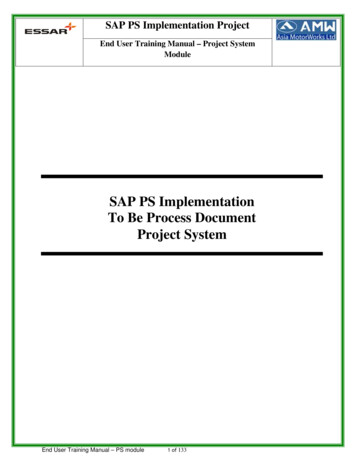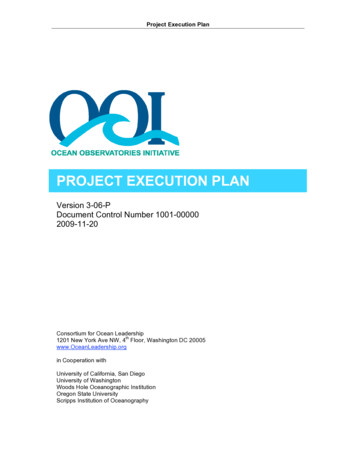
Transcription
Project Execution PlanPROJECT EXECUTION PLANVersion 3-06-PDocument Control Number 1001-000002009-11-20Consortium for Ocean Leadershipth1201 New York Ave NW, 4 Floor, Washington DC 20005www.OceanLeadership.orgin Cooperation withUniversity of California, San DiegoUniversity of WashingtonWoods Hole Oceanographic InstitutionOregon State UniversityScripps Institution of Oceanography
Project Execution PlanDocument Control SheetVersion3-06-PDescriptionPublic versionNote: This document has been edited to remove information that is considered confidentialand/or sensitive to ongoing or future financial negotiations for OOI procurements. Informationremoved has been replaced by the insertion of “[redacted]”.Ver 3-06-P1001-00000i
Project Execution PlanTable of Contents:Document Control Sheet . iExecutive Summary .11 Overview .11.1 Scientific Goals .31.2 Technical Description .62 Construction Approach.92.1 Design and Development Strategy .92.2 Construction and Installation Strategy .92.3 Initial Operations Strategy and Commissioning .103 Project Management .103.1 Management and Oversight Structure .103.2 Community Advisory Structure .123.3 Interagency and International Partnerships.133.4 Work Breakdown Structure .163.5 Cost and Schedule Management .173.6 Financial Management.193.7 Configuration Management and Change Control .193.7.1Requirements Management.193.7.2Interface Management.213.8 Quality Assurance and Quality Control .233.9 Risk Management.233.10Environmental Health and Safety .253.11Permits and Environmental Compliance .253.11.1Environmental Compliance .253.11.2Permitting Responsibility .263.12Testing and Acceptance .263.13Annual Work Plans .273.14Document Control and Reporting .273.15Contingency Management .283.16IO Selection, Performance Management, and Acquisition Planning .293.16.1Selection of IOs: Marine Infrastructures, Cyberinfrastructure, and Education andPublic Engagement Infrastructures .293.16.2Management of IO Subaward Performance .293.16.3Acquisition Planning for New Subawards .303.17Property Management .304 Security .314.1 Physical Security .314.2 Cyberinfrastructure Security .314.3 Operational Security.315 Operations and Maintenance.325.1 Operations and Maintenance Planning.325.2 Science Planning .325.3 Service levels, maintenance, and logistics approaches .345.4 Estimate of Operational Costs.346 Reviews .35Appendix A-1: Documents Incorporated by Reference .37Appendix A-2: Acronym List .38Appendix A-3: Current Membership, Program Advisory Committee.40Appendix A-4: Technical Summary .41Appendix A-5: PMO and IO Organizational Structure .47Ver 3-06-P1001-00000ii
Project Execution PlanExecutive SummaryThe Ocean Observatories Initiative (OOI) project will construct an interactive, globally distributed,and integrated network of ocean nodes that create an observatory enabling transformational,complex, interdisciplinary ocean science.The National Research Council (NRC) recommended that the OOI management structure shouldbe one in which the day-to-day operation of different OOI elements is the responsibility of entitieswith appropriate scientific and technical expertise, while the role of the program managementorganization should be one of coordination, oversight, and fiscal and contract management. In2004 NSF signed a cooperative agreement with the Joint Oceanographic Institutions (JOI), nowthe Consortium for Ocean Leadership, for the establishment of a project office to coordinate theOOI activities. This resulted in the creation of the current OOI Program Office. After a competitivebid process, Ocean Leadership signed subawards with three implementing organizations (IOs) toconduct the detailed design, engineering, construction, testing, and operation of the different OOIelements.The OOI Project Execution Plan (PEP) describes how Ocean Leadership manages the OOIproject. OOI construction will be funded by the National Science Foundation (NSF) through itsMajor Research Equipment and Facilities Construction (MREFC) account. The Large FacilitiesOffice at NSF has set out guidelines for the management of MREFC projects, and the PEPattempts to be responsive to the spirit of those guidelines.In this spirit, Ocean Leadership will conduct design reviews at appropriate times within eachImplementing Organization’s schedule of activities. The OOI Project Baseline has beenestablished and is in Appendix A-4.This version of the PEP was created to incorporate the changes approved by the NationalScience Board (NSB) in May 2009. It will be modified as the project moves forward. Thephilosophy in writing this PEP is to incorporate a number of existing (or planned) supportingdocuments by reference. This allows the supporting documents to be updated without impactingthe PEP. A list of program documents supporting this PEP is found in Appendix A-1.1OverviewThe Ocean Observatories Initiative (OOI) Project Execution Plan (PEP) is viewed as a livingdocument and will be updated throughout the development and implementation phases of theOOI. This version of the document represents the approach planned at MREFC project initiation.Subsequent versions will be issued as the project reaches critical milestones or when externalfactors, such as final decisions on each year's federal budget, materialize. Substantive changesto the PEP, following major reviews or significant project changes will be sent to the cognizantNational Science Foundation (NSF) program officer for written approval.The OOI Program will conduct transformational ocean science using an integrated oceanobservatory with a network of interactive nodes studying interrelated ocean processes on coastal,regional, and global spatial scales and over a range of time scales, from microseconds todecades. NSF will fund the planned facility through its Major Research Equipment and FacilitiesConstruction (MREFC) account. The OOI is an outgrowth of scientific planning efforts by thenational and international ocean research communities over the past two decades and ismotivated in part by rapidly expanding development of computational, robotic, communications,and sensor capabilities.Ver 3-06-P1001-00000Page 1 of 51
Project Execution PlanThe OOI program is managed through the OOI Program Office housed within the Consortium forOcean Leadership (Ocean Leadership) in Washington, D.C. Ocean Leadership is a not-for-profitcorporation of member institutions (universities or other nonprofit institutions, organizations, orgovernmental entities involved in oceanographic sciences or related fields and that are organizedfor educational or scientific purposes). Ocean Leadership has contracted with three implementingorganizations (IOs) for the development, construction, and operation of the OOI. The WoodsHole Oceanographic Institution is the IO for the coastal and global nodes, the University ofWashington for the regional nodes, and the University of California, San Diego for thecyberinfrastructure that connects the nodes together into an integrated observatory. A fourthimplementing partner for building related education and public engagement infrastructure will beidentified through a competitive procurement process after MREFC project initiation. Figure 1shows the responsibilities of Ocean Leadership and each IO in the execution of the OOI project.Each IO has developed a PEP covering its responsibilities. These subordinate PEP documentsare consistent with this OOI PEP and are incorporated by reference in accordance withAppendix A-1.Figure 1 Responsibilities of Ocean Leadership and each Implementing OrganizationNSF's guidance is to plan the OOI with a technically driven funding profile and allocation:OOI Funding [redacted]PY 1Project OfficeContingencyCyber IOCoastal/Global IORegional IOEducation IOTotal OOIVer 3-06-PPY 2PY 31001-00000PY 4PY 5PY 6TotalPage 2 of 51
Project Execution PlanThe funding profile and allocation above has been derived from a technically drivenimplementation schedule and based upon a rolled-up costing of approximately 900 individualwork packages. The funding profile in this chart includes approximately 30% contingency. Thecontingency value was calculated as part of the bottom-up cost estimate contained in the OOICost Book (20%) and the OOI Risk Register (10%), both held by Ocean Leadership. The CostBook based contingency value will be removed from each IO's budget and managed at the OOIoverall project level. The funding profile above includes funds required to commit contracts priorto the year in which payment is made, the OOI Cost Book is the cost estimate controlled source.This schedule assumes funds for the OOI construction will be provided by NSF in a timelymanner to support a September 1, 2009, MREFC project initiation. Project planning andpreparation for implementation will continue through FY 2009 and close out in the first quarter ofFY2010, providing a transition to MREFC. This period is referred to as the “Pilot Period.”The current OOI website (http://www.oceanleadership.org/ocean observing) serves as a baselinesource of community information about the program. The website includes information anddocuments regarding the management, science planning, design refinement and other newsrelated to the OOI. Work on a more dynamic, comprehensive web presence will commenceduring the Pilot Period.1.1Scientific GoalsThe vast oceans, which cover two-thirds of our planet, largely determine the quality of life onEarth and are the last unexplored frontiers on our planet. The complex interacting environmentsand processes that operate within the world’s oceans modulate both short-term and long-termvariations in climate, harbor major energy and raw material resources, contain and support thelargest biosphere on Earth, significantly influence rainfall and temperature patterns on land, andoccasionally devastate heavily populated coastal regions with severe storms or tsunamis.Phenomena such as global climate change and El Niño events, and natural hazards such ashurricanes and tsunamis have enormous global economic and societal impact.Many earth and ocean processes occur at temporal and spatial scales not effectively sampledusing traditional ship-based or satellite-based observations. Such processes run the spectrumfrom episodic, short-lived events (earthquakes, submarine volcanic eruptions, severe storms), tolonger-term changes or emergent phenomena (ocean circulation patterns, climate change, oceanacidity, ecosystem trends). The need for sustained ocean observations has long beenrecognized by the ocean science community and was re-affirmed in 2004 by the U.S.Commission on Ocean Policy in its report (http://www.oceancommission.gov/).The overarching goal of NSF’s OOI is to advance the investigation of complex earth and oceanprocesses by providing access to next-generation (i.e., transformational) technologies to supportinteractive and adaptive observatory science. The NSF’s MREFC account will support theconstruction of an integrated observatory network to operate as a “permanent observationalpresence” in the ocean. The OOI Network will provide scientists with unique opportunities toconduct multi-disciplinary studies of linked atmosphere-ocean-earth processes over timescales ofseconds to decades, and spatial scales of millimeters to thousands of kilometers.The OOI will transform research of the oceans by establishing a network of interactive, globallydistributed sensors with near real-time data access. Recent technological advances in sensors,computational speed, communication bandwidth, Internet resources, miniaturization, genomicanalyses, high-definition imaging, robotics and data assimilation-modeling-visualizationtechniques are opening new possibilities for remote scientific inquiry and discovery. The OOI willenable innovative developments across all of these fields and will contribute to maintainingAmerican leadership in scientific advancement as well as providing excellent educationalopportunities. The OOI is the NSF’s major contribution to the broader national and internationalefforts to establish the U.S. Integrated Ocean Observing System (IOOS) and the Global EarthObservation System of Systems (GEOSS), respectively.Ver 3-06-P1001-00000Page 3 of 51
Project Execution PlanThe OOI is the result of almost twenty years of community planning. The scientific goals (i.e., thehigh-priority-research topics and questions) and types of infrastructure required to address thosescientific goals are based on recommendations contained in more than thirty planningdocuments, including workshop reports, interagency reports, and two National Academy ofSciences publications. A more detailed description of OOI development and science goals isavailable in the OOI Science Prospectus titled The Ocean Observatories Initiative ScientificObjectives and Network Design: A Closer Look. As summarized in the OOI Science Prospectusand the earlier Ocean Observatories Initiative Science Plan, the scientific goals of the OOI are toprovide the necessary infrastructure to enable profound advancements in the following researchareas: Ocean-Atmosphere ExchangeClimate Variability, Ocean Circulation, and EcosystemsTurbulent Mixing and Biophysical InteractionsCoastal Ocean Dynamics and EcosystemsFluid-Rock Interactions and the Subseafloor BiospherePlate-Scale, Ocean GeodynamicsThe design goals established in the National Research Council (NRC) report Enabling OceanstResearch in the 21 Century: Implementation of a Network of Ocean Observatories are theguiding principles applied to the OOI Network design to ensure that OOI capabilities will addressthe science goals. Those guiding principles are: (1) continuous observations at high temporalresolution for decades; (2) spatial measurements on scales ranging from millimeter to kilometers;(3) the ability to collect data during storms and other severe conditions; (4) two-way datatransmission and remote instrument control; (5) power delivery to sensors between the seasurface and the seafloor; (6) standard sensor interfaces; (7) autonomous underwater vehicles(AUV) docks for data download and battery recharge; (8) access to facilities to deploy, maintain,and calibrate sensors; (9) an effective data management system that provides open access to all;and (10) an engaging and effective education and outreach program that increases oceanliteracy.The series of planning activities leading up to release of the OOI Conceptual Network Design(CND) and the OOI Preliminary Network Design (PND) have involved the efforts of hundreds ofocean scientists, computer scientists, engineers, and educators spanning 130 research andeducation institutions. The OOI Final Network Design (FND) has been refined from the OOI PNDto define, with higher confidence, the financial resources and schedule needed to accomplish thetechnical baseline. The technical baseline has been adjusted slightly to align, with higherconfidence, with NSF’s guidance on anticipated Operations and Maintenance funding. Otherchanges have been introduced to reduce risk and include technical information gained throughseveral Requests for Proposal and Requests for Information. Changes were introduced to betteralign system capability with the lower level system requirements defined since Preliminary DesignReview (PDR) in November 2007. Most recently, following FDR, NSF requested specificchanges to enhance the capability of the OOI to address the current need for betterunderstanding of the ocean’s role in the global carbon cycle and climate change, oceanacidification, ocean health and marine ecosystems. These changes in capability were approvedby the NSB in May 2009.The OOI facility incorporates marine infrastructure to observe the ocean over spatial and timescales relevant to a diverse and interconnected environment; it is organized operationally bysubsystems. The major subsystems of the OOI Network are the Global Scale Nodes, theRegional Scale Nodes, the Coastal Scale Nodes, the integrating Cyberinfrastructure, and theEducation and Public Engagement Infrastructure. Together these subsystems provide the uniquecapability to address high-level questions such as how the ocean responds to the two basicstressors on the planet – heat from above in the form of solar radiation, and heat from below inthe form of geothermal heat. Another high-level question that will be addressed by the integratedcapabilities of the OOI includes how climate change and variability will influence diverse oceanecosystems and how CO2 uptake and ocean acidification are changing ocean properties.Ver 3-06-P1001-00000Page 4 of 51
Project Execution PlanThe Global Scale Nodes (GSN) will support air-sea, water-column, and seafloor sensorsoperating in remote, but scientifically important locations. The scientific goals are to provideobservations of processes at critical high-latitude sites for which little or no time series data exist:air-sea interactions and gas exchange, the global carbon cycle, ocean acidification, and globalgeodynamics.The Regional Scale Nodes (RSN) will enable studies of water column, seafloor, and sub-seafloorprocesses using high-powered, high-bandwidth instrument arrays cabled to shore. The sciencedrivers of the RSN are investigations into the structure of Earth’s crust; seismicity, magmatism,and deformation across the Juan de Fuca Plate; water, heat, and chemistry fluxes ofhydrothermal systems; benthic ecosystems; circulation and mixing at gyre boundaries;biogeochemistry and ecosystem dynamics.The Coastal Scale Nodes (CSN) will support long-term and high space-time resolutionobservations to understand the physics, chemistry, ecology, and climate science of key regions ofthe complex coastal ocean. The scientific goals include providing observations of phenomenasuch as: variability in complex eastern and western boundary current systems; coupling betweencoastal physics and biology, including nearshore fisheries and biological regime shifts; coastalcarbon budgets; terrestrial-oceanic transport of carbon, nutrients, sediments, and fresh water;shelf, shelfbreak and slope exchanges; and coastal hazards such as storms, tsunamis, andhypoxia.These three elements of the OOI marine infrastructure will provide the unique new observationsthat when taken together with existing observations integrate to form the observing capabilityneeded for the high-level science questions. For example, air-sea exchange at critical highlatitude sites, where present uncertainties are large and no sustained observatory capabilityexists, will be quantified by the GSN; key western and eastern boundary current regimes that playa role in meridional transports and are recipients of climate signals from the poles and theequator will have comprehensive sampling by the CSN; and RSN will instrument the sea floor andobserve its interaction with the slow, deep flow that completes the large scale circulationpathways. Hypotheses about ecosystem change can be tested in contrasting regimes beingsampled simultaneously: the high-latitude open ocean where strong climate signals are nowseen, the benthic ocean that should be isolated from the immediacy of changes in surface fluxes,and the coastal ocean where shelf topography, strong water mass property gradients, andpropagation of signals from polar and equatorial regimes as well as basin scale modes are seen.The OOI’s broadly distributed, multi-scale network of observing assets are bound together by aninteractive Cyberinfrastructure (CI) backbone that will link the physical infrastructure elements,sensors, and data into a coherent system of systems. The CI will support the OOI science goalsby providing a range of capabilities. The OOI CI will enable anyone—scientist, engineer, oreducator—to have access to two-way interactivity, command and control, and resources (e.g.,instruments, near-real-time data, historic data archives). The CI will permit mediation amongdifferent protocols, data streams, and derived data products. In accordance with the OOI datapolicy, calibrated and quality-controlled data will be made publicly available with minimal delay.The OOI will also enable the effective translation of its capabilities and results into forms morereadily usable by students, educators, workforce participants, and decision-makers via aneducation and public engagement (EPE) infrastructure. The EPE infrastructure will be designed inresponse to Education User Requirements that are closely related to standard ocean literacyprinciples. The requirements focus on the need for tools such as web-based interfaces,interactive visualization of data streams, simulations from simplified ocean models, merging withnon-OOI databases, virtual participation in OOI science activities, a comprehensive database ofeducation-relevant products with interfaces that are appropriate for cultural diversity, and socialnetworking to enable collaborative workspaces.The OOI promises to transform ocean sciences and open entirely new avenues of research,encourage the development and application of new sensors and technologies, provide newopportunities to convey the importance of the oceans to students and the general public, andprovide essential information for decision-makers responsible for developing ocean policy.Ver 3-06-P1001-00000Page 5 of 51
Project Execution Plan1.2Technical DescriptionThe infrastructure provided to research scientists through the OOI will include the cables, buoys,deployment platforms, moorings and junction boxes, required power, and two-way datacommunication to support a wide variety of sensors at the sea surface, in the water column, andat or beneath the seafloor. A core suite of 49 sensor types chosen to best answer questionsbased on the science themes and distributed across the platforms is also included. The initiativealso includes components such as unified project management, a cyberinfrastructure (CI) for datacapture, dissemination and archiving, and education and public awareness activities essential tothe long-term success of ocean observatory science.At completion, the OOI observatory system will have the capabilities to provide: Continuous observations over a range of time scales of seconds to decades Spatial measurements on scales ranging from millimeters to kilometers Sustained operations during storms and other severe conditions Real-time or near-real-time data as appropriate Two-way transmission of data and remote instrument control Power delivery to sensors between the sea surface and the seafloor The usage of gliders and autonomous underwater vehicles (AUVs) to expand thefootprint of measurements at selected sites Facilities for instrument maintenance and calibration A data management system that makes data publicly available Infrastructure enabling effective education and public engagement activities Expansion of the system (space, power, bandwidth and technical support) to hostnew instruments and sensors.The OOI facility will comprise networked marine infrastructure with integrating cyberinfrastructureand related education and public engagement infrastructure. The marine infrastructure will collectdata over spatial and temporal scales relevant to a diverse and interconnected oceanenvironment through a loosely grouped set of costal, regional, and global scale nodes. Thesesubsystems of the OOI provide platforms for multi-disciplinary observations and experiments:1. Coastal Scale Nodes (CSN): New observing facilities in contrasting coastal boundary currentregimes on the East and West Coasts of the U.S.2. Regional Scale Nodes (RSN): A regional electro-optical cabled network consisting ofinterconnected sites on the seafloor spanning multiple geological and oceanographic featuresand processes. The RSN is linked to the Coastal Endurance Array to provide power andbandwidth at two locations on that array.3. Global Scale Nodes (GSN): Autonomous moored buoy platforms at four deep water, highlatitude locations are key to capturing large-scale ocean-atmosphere coupling where therehas been little or no previous sustained coverage.The subsystems are integrated through the CI, which provides connections to scientists andclassroom, and allows the OOI to function as a single, secure, integrated network.Ver 3-06-P1001-00000Page 6 of 51
Project Execution nsResearchPlatformsShore SideOperationsObservatoryOperationsEnd UserOperationsFixedCoreMobileCoreMarine NetObservatory NetMarineManagementObservatoryManagementMarine OperatorCyber OperatorScienceTeams &EducatorsUser EnvironmentManagementU serMarineOperationalAuthorityC yberAdministratorFigure 2. OOI Integrated Observatory.Figure 2 shows the different operational domains that together form the OOI IntegratedObservatory. The two marine observatories, RSN and CGSN, each represent one operationaldomain, both connected to the operational domain maintained by the CI IO, representing theIntegrated Observatory to its users. The EPE infrastructure, once developed, will likely reside inthe CI domain with interface agreements to be specified more completely by negotiation betweenthe CI IO and the EPE IO once the EPE IO has been identified. Most end users interacting withthe integrated observatory, such as scientist and education teams, define their own operationaldomains. The lines and clouds in Figure 2 represent communication networks and the nodesrepresent physical sites with computation and sto
Project Execution Plan PROJECT EXECUTION PLAN Version 3-06-P Document Control Number 1001-00000 2009-11-20 Consortium for Ocean Leadership 1201 New York Ave NW, 4th Floor, Washington DC 20005 www.OceanLeadership.org in Cooperation with University of California, San Diego University of Washington Woods Hole Oceanographic Institution
